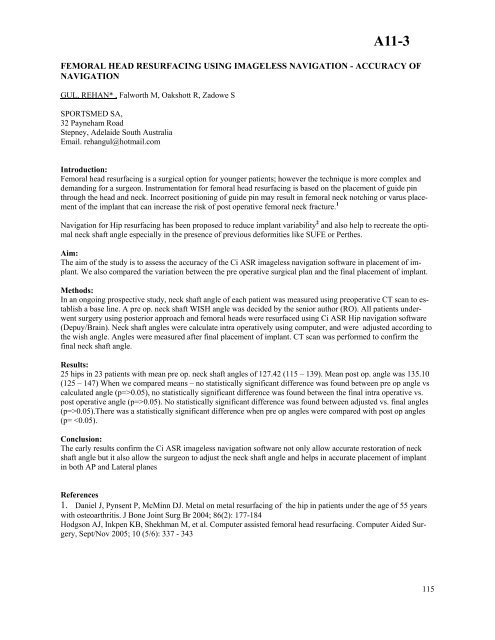ista 2007 program at a glance
ista 2007 program at a glance
ista 2007 program at a glance
Create successful ePaper yourself
Turn your PDF publications into a flip-book with our unique Google optimized e-Paper software.
FEMORAL HEAD RESURFACING USING IMAGELESS NAVIGATION - ACCURACY OF<br />
NAVIGATION<br />
GUL, REHAN* , Falworth M, Oakshott R, Zadowe S<br />
SPORTSMED SA,<br />
32 Payneham Road<br />
Stepney, Adelaide South Australia<br />
Email. rehangul@hotmail.com<br />
A11-3<br />
Introduction:<br />
Femoral head resurfacing is a surgical option for younger p<strong>at</strong>ients; however the technique is more complex and<br />
demanding for a surgeon. Instrument<strong>at</strong>ion for femoral head resurfacing is based on the placement of guide pin<br />
through the head and neck. Incorrect positioning of guide pin may result in femoral neck notching or varus placement<br />
of the implant th<strong>at</strong> can increase the risk of post oper<strong>at</strong>ive femoral neck fracture. 1<br />
Navig<strong>at</strong>ion for Hip resurfacing has been proposed to reduce implant variability 2 and also help to recre<strong>at</strong>e the optimal<br />
neck shaft angle especially in the presence of previous deformities like SUFE or Perthes.<br />
Aim:<br />
The aim of the study is to assess the accuracy of the Ci ASR imageless navig<strong>at</strong>ion software in placement of implant.<br />
We also compared the vari<strong>at</strong>ion between the pre oper<strong>at</strong>ive surgical plan and the final placement of implant.<br />
Methods:<br />
In an ongoing prospective study, neck shaft angle of each p<strong>at</strong>ient was measured using preoper<strong>at</strong>ive CT scan to establish<br />
a base line. A pre op. neck shaft WISH angle was decided by the senior author (RO). All p<strong>at</strong>ients underwent<br />
surgery using posterior approach and femoral heads were resurfaced using Ci ASR Hip navig<strong>at</strong>ion software<br />
(Depuy/Brain). Neck shaft angles were calcul<strong>at</strong>e intra oper<strong>at</strong>ively using computer, and were adjusted according to<br />
the wish angle. Angles were measured after final placement of implant. CT scan was performed to confirm the<br />
final neck shaft angle.<br />
Results:<br />
25 hips in 23 p<strong>at</strong>ients with mean pre op. neck shaft angles of 127.42 (115 – 139). Mean post op. angle was 135.10<br />
(125 – 147) When we compared means – no st<strong>at</strong>istically significant difference was found between pre op angle vs<br />
calcul<strong>at</strong>ed angle (p=>0.05), no st<strong>at</strong>istically significant difference was found between the final intra oper<strong>at</strong>ive vs.<br />
post oper<strong>at</strong>ive angle (p=>0.05). No st<strong>at</strong>istically significant difference was found between adjusted vs. final angles<br />
(p=>0.05).There was a st<strong>at</strong>istically significant difference when pre op angles were compared with post op angles<br />
(p=
















